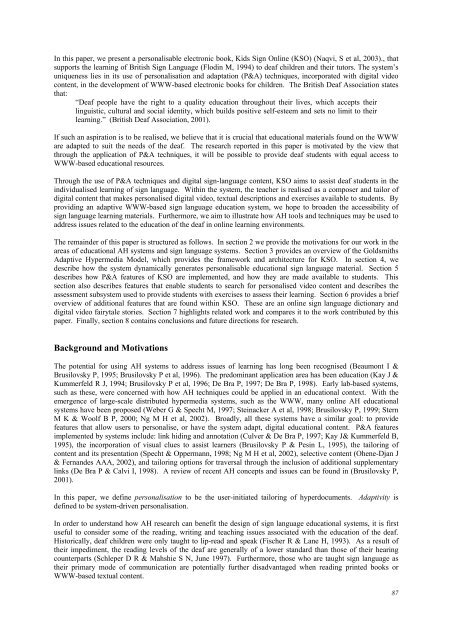A Personalisable Electronic Book for Video-based Sign Language ...
A Personalisable Electronic Book for Video-based Sign Language ...
A Personalisable Electronic Book for Video-based Sign Language ...
Create successful ePaper yourself
Turn your PDF publications into a flip-book with our unique Google optimized e-Paper software.
In this paper, we present a personalisable electronic book, Kids <strong>Sign</strong> Online (KSO) (Naqvi, S et al, 2003)., that<br />
supports the learning of British <strong>Sign</strong> <strong>Language</strong> (Flodin M, 1994) to deaf children and their tutors. The system’s<br />
uniqueness lies in its use of personalisation and adaptation (P&A) techniques, incorporated with digital video<br />
content, in the development of WWW-<strong>based</strong> electronic books <strong>for</strong> children. The British Deaf Association states<br />
that:<br />
“Deaf people have the right to a quality education throughout their lives, which accepts their<br />
linguistic, cultural and social identity, which builds positive self-esteem and sets no limit to their<br />
learning.” (British Deaf Association, 2001).<br />
If such an aspiration is to be realised, we believe that it is crucial that educational materials found on the WWW<br />
are adapted to suit the needs of the deaf. The research reported in this paper is motivated by the view that<br />
through the application of P&A techniques, it will be possible to provide deaf students with equal access to<br />
WWW-<strong>based</strong> educational resources.<br />
Through the use of P&A techniques and digital sign-language content, KSO aims to assist deaf students in the<br />
individualised learning of sign language. Within the system, the teacher is realised as a composer and tailor of<br />
digital content that makes personalised digital video, textual descriptions and exercises available to students. By<br />
providing an adaptive WWW-<strong>based</strong> sign language education system, we hope to broaden the accessibility of<br />
sign language learning materials. Furthermore, we aim to illustrate how AH tools and techniques may be used to<br />
address issues related to the education of the deaf in online learning environments.<br />
The remainder of this paper is structured as follows. In section 2 we provide the motivations <strong>for</strong> our work in the<br />
areas of educational AH systems and sign language systems. Section 3 provides an overview of the Goldsmiths<br />
Adaptive Hypermedia Model, which provides the framework and architecture <strong>for</strong> KSO. In section 4, we<br />
describe how the system dynamically generates personalisable educational sign language material. Section 5<br />
describes how P&A features of KSO are implemented, and how they are made available to students. This<br />
section also describes features that enable students to search <strong>for</strong> personalised video content and describes the<br />
assessment subsystem used to provide students with exercises to assess their learning. Section 6 provides a brief<br />
overview of additional features that are found within KSO. These are an online sign language dictionary and<br />
digital video fairytale stories. Section 7 highlights related work and compares it to the work contributed by this<br />
paper. Finally, section 8 contains conclusions and future directions <strong>for</strong> research.<br />
Background and Motivations<br />
The potential <strong>for</strong> using AH systems to address issues of learning has long been recognised (Beaumont I &<br />
Brusilovsky P, 1995; Brusilovsky P et al, 1996). The predominant application area has been education (Kay J &<br />
Kummerfeld R J, 1994; Brusilovsky P et al, 1996; De Bra P, 1997; De Bra P, 1998). Early lab-<strong>based</strong> systems,<br />
such as these, were concerned with how AH techniques could be applied in an educational context. With the<br />
emergence of large-scale distributed hypermedia systems, such as the WWW, many online AH educational<br />
systems have been proposed (Weber G & Specht M, 1997; Steinacker A et al, 1998; Brusilovsky P, 1999; Stern<br />
M K & Woolf B P, 2000; Ng M H et al, 2002). Broadly, all these systems have a similar goal: to provide<br />
features that allow users to personalise, or have the system adapt, digital educational content. P&A features<br />
implemented by systems include: link hiding and annotation (Culver & De Bra P, 1997; Kay J& Kummerfeld B,<br />
1995), the incorporation of visual clues to assist learners (Brusilovsky P & Pesin L, 1995), the tailoring of<br />
content and its presentation (Specht & Oppermann, 1998; Ng M H et al, 2002), selective content (Ohene-Djan J<br />
& Fernandes AAA, 2002), and tailoring options <strong>for</strong> traversal through the inclusion of additional supplementary<br />
links (De Bra P & Calvi I, 1998). A review of recent AH concepts and issues can be found in (Brusilovsky P,<br />
2001).<br />
In this paper, we define personalisation to be the user-initiated tailoring of hyperdocuments. Adaptivity is<br />
defined to be system-driven personalisation.<br />
In order to understand how AH research can benefit the design of sign language educational systems, it is first<br />
useful to consider some of the reading, writing and teaching issues associated with the education of the deaf.<br />
Historically, deaf children were only taught to lip-read and speak (Fischer R & Lane H, 1993). As a result of<br />
their impediment, the reading levels of the deaf are generally of a lower standard than those of their hearing<br />
counterparts (Schleper D R & Mahshie S N, June 1997). Furthermore, those who are taught sign language as<br />
their primary mode of communication are potentially further disadvantaged when reading printed books or<br />
WWW-<strong>based</strong> textual content.<br />
87
















